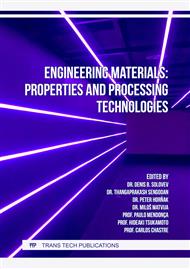[1]
B. Fakhlman, Chemistry of new materials and nanotechnology, Tutorial. Per. from English: Scientific publication, Dolgoprudny: Intellect Publishing House, 2011, p.464.
Google Scholar
[2]
Yu.V. Trushin, Physical foundations of materials science. Second edition (revised and enlarged): textbook. Allowance, SPb.: Publishing house of the Academic University, 2015, p.356.
Google Scholar
[3]
Physical materials science: textbook for universities: In 6 volume, Ed. B.A. Kalina, Vol. 1, Solid State Physics, Moscow: MEPhI, 2007.
Google Scholar
[4]
A.M. Salakhov, Introduction to the technology of structural materials, Textbook for students of the Institute of Physics, Kazan: K (P) FU, 2014, p.149.
Google Scholar
[5]
M.B. Lachinov, General ideas about polymers, Edited by Professor V.P. Shibaev, Moscow, 2003.
Google Scholar
[6]
A.A. Tager, Physico-chemistry of polymers, Chemistry, 1978.
Google Scholar
[7]
Workshop on chemistry and physics of polymers: textbook. ed. N.I. Avvakumova, L.A. Budarin, S.M. Divgun, ed. V.F. Kurenkov, Ed. 3rd, M.: Chemistry, 1995, p.256.
Google Scholar
[8]
G.M. Bartenev, Physics and Mechanics of Polymers: Textbook. Manual for universities, M.: Higher school, 1983, p.391.
Google Scholar
[9]
A.A. Tartanov, Basics of processing polymeric materials, Part 1 and 2, Textbook for universities, Mines: YURGUES, 2001, p.72.
Google Scholar
[10]
R.G. Sayapova, etc., New elastic material: partially crystalline polymer - syndiotactic 1,2-polybutadiene, Electronic scientific journal "Petroleum engineering". 6 (2012) 495-501.
Google Scholar
[11]
I.S. Rez, Dielectrics, Main properties and applications in electronics, M.: Radio and communication, 1989, p.288.
Google Scholar
[12]
I.A. Malyshkina, Fundamentals of the method of dielectric spectroscopy, Textbook, Moscow: Faculty of Physics, Moscow State University, 2012, p.80.
Google Scholar
[13]
R.G. Rakhmatullina, Frequency and temperature dependences of the dielectric constant and the loss-angle tangent of some nematic liquid crystals, Electronic scientific journal "Petroleum engineering". 3 (2014) 207-222.
Google Scholar
[14]
R.G. Rakhmatullina, AFM research of a deformed elastomer, Petroleum engineering. Vol. 12, 2 (2014) 140-146.
Google Scholar
[15]
S.M. Usmanov, Relaxation polarization of dielectrics. Calculation of the spectra of dielectric relaxation time, M .: Science. Fizmatlit, 1996, p.144.
Google Scholar
[16]
A.R. Blythe, D. Bloor, Electrical properties of polymers, Moscow: Fizmatlit, 2008, p.376.
Google Scholar
[17]
M.L. Williams, The Temperature Dependence of Relaxation Mechanisms in Amorphous Polymers and Other Glass-forming Liquids, J. Amer. Chem. Soc. Vol. 77, 14 (1955) 3701-3707.
DOI: 10.1021/ja01619a008
Google Scholar
[18]
A.K. Jonscher, Dielectric relaxation in solids, J. Phys. D: Appl. Phys. Vol. 32 (1999) 57-70.
Google Scholar
[19]
J.P. Runt, R.J. Fitzgerald (Eds.), Dielectric spectroscopy of polymeric materials: fundamentals and applications, Washington, DC: American Chemical Society, 1997, p.461.
Google Scholar
[20]
R.G. Sayapova, Frequency and temperature dependences of dipole-segmental and dipole-group polarization in polymers and liquid crystals, Dis ... cand. phys.-mat. Sciences, Ufa: BashSU, 2012, p.126.
Google Scholar
[21]
J. Cai [and others], Crystallization behavior of syndiotactic and atactic 1,2-polybutadiene blends, Polymer International. Vol. 53 (2004) 11-27.
Google Scholar
[22]
Y. Obata, Bulk properties of syndiotactic 1,2-polybutadiene, I. Thermal and viscoelastic properties, Polymer Journal. Vol. 7, 2 (1975) 207-216.
DOI: 10.1295/polymj.7.207
Google Scholar
[23]
Y. Obata, Bulk properties of syndiotactic 1,2-polybutadiene, II Mechanical properties of uniaxially and biaxially stretched films in relation to molecular orientation, Polymer Journal. Vol. 7, 2 (1975) 217-227.
DOI: 10.1295/polymj.7.217
Google Scholar
[24]
M.I. Abdullin, Viscoelastic and rheological properties of syndiotactic 1,2-polybutadiene, Journal applied chemistry. Vol. 80, 11 (2007) 1913-1917.
Google Scholar
[25]
R.G. Rakhmatullina, Dipole-segmental process of polarization in partially crystalline polymers, Bashkir Chemical Journal. Vol. 22, 3 (2015) 45-48.
Google Scholar
[26]
A.N. Chuvyrov, Influence of ion-forming additives on the electrical properties of paraffin-containing disperse systems, Electronic journal "Petroleum Engineering". 2 (2010) 72-75.
Google Scholar
[27]
Z.H. Kuvatov, AFM - research of cholesteric liquid crystal in the glassy state, Vestnik BSU. 2 (2005) 27-29.
Google Scholar
[28]
K.L. Sorokina, A.L. Tolstikhina, Modification of atomic force microscopy for studying the electrical properties of crystals and films, Overview, Crystallography. Vol. 49, 3 (2004) 541-565.
DOI: 10.1134/1.1756648
Google Scholar
[29]
S.N. Magonov, Surface Analysis with STM and AFM: experimental and theoretical aspects of image analysis, New York, Basel, Cambridge, Tokyo: VHC. 1996, p.318.
Google Scholar
[30]
F.M. Girfanova, Investigation of phase states of thin films of liquid crystals by atomic force microscopy, Dis ... sciences, Ufa, 2008, p.122.
Google Scholar
[31]
A.L. Tolstikhina, Atomic force microscopy of crystals and films with complex surface morphology, Dis ... cand. phys.-mat. sciences, Moscow, 2013, p.333.
Google Scholar
[32]
R.G. Sayapova, others, Electrical properties of initial and deformed elastomers, Bashkir Chemical Journal, Vol. 20, 4 (2013) 54-58.
Google Scholar
[33]
A.N. Chuvyrov, Technology of obtaining new polymer modifications of syndiotactic 1,2-polybutadiene and their electrical properties, Chelyabinsk Physics and Mathematics Journal. 39(254) (2011) 35-41.
Google Scholar
[34]
R.G. Rakhmatullina, Dielectric relaxation method in polymeric materials, In the collection: Modern achievements of agrarian science: scientific works of the All-Russian (national) scientific-practical conference dedicated to the 80th anniversary of Doctor of Agricultural Sciences, Professor, Corresponding Member. RAS, honorary member of the Academy of Sciences of the Republic of Tatarstan, academician of the AIRT, three times Laureate of the State and Government Prizes in the field of science and technology, Honored Scientist of the Russian Federation, Honored Worker of Agriculture of the Republic of Tatarstan, 2020, pp.285-290
DOI: 10.17803/1994-1471.2017.82.9.219-223
Google Scholar


